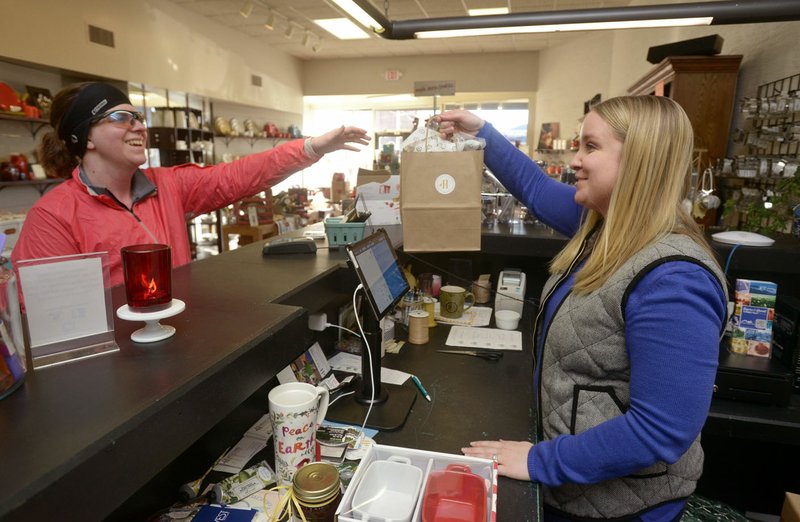ROGERS -- Development continues to build as the city's downtown plan evolves.
The plan is a vision for downtown to have more retail, restaurants, activities for the public and job opportunities, said Karen Wagaman, vice president of downtown development at the Rogers-Lowell Area Chamber of Commerce. About 26 businesses opened downtown in 2016, and already 12 more are planned for this year, including Haas Hall in the old Lane Hotel.
Web watch
Rogerspulse.com has business owner profiles and updates to the downtown Rogers master plan.
Source: Staff report
The comprehensive plan includes improvement to streets, parks and utilities paid for with a combination of city money, bonds, and public and private partnerships. It combines the efforts of the city with several organizations -- including Main Street Rogers, Visit Rogers and the Rogers Downtown Partners -- to bring more businesses, recreation and interest to the downtown area.
"Part of the city's approach to this plan is taking a holistic approach to shaping the future of downtown," said Ben Cline, public relations specialist for Rogers. "We're looking at the big picture through zoning and changes to the city code that will align future development."
Gateway Planning Group of Texas was contracted to create the plan in 2014, and the plan took 18 months to develop. The plan was finalized in 2015, when a website was created and a change in city zoning for the downtown area condensed eight zones to four -- core mixed-use, commercial mixed-use, industrial arts and neighborhood transition.
Area developers, Realtors and other planning officials contributed to the change.
"The master plan gives a uniform, unified growth plan that we can all use to develop our businesses," said Brad Vandris, co-owner of Pop's Hogwild BBQ. "Just having it presents a pathway that we can all have something consistent that we're working toward. Without it, you're working without a rope."
Vandris said he likes the plan because it's adaptable and not set in stone but provides a structure that's useful when building a business.
The new zoning makes moving to downtown more attractive to business owners and phased out the entry of gas stations, auto mechanics and other such businesses to the area, said Wagaman, who was hired to oversee the implementation of the plan, which will take years of progress. Mayor Greg Hines previously mentioned a likelihood the city would pay for a significant portion of the position's salary.
Last year was the first year to see results beyond planning.
"The chamber and the city came together to identify needs in downtown and bring people together," Wagaman said. "They spoke with people, and it was clear that downtown was something they were proud of and wanted to be more a part of."
A few of the plan's accomplishments in its first full year include the $17.5 million construction and renovation of Lake Atalanta Park; creation of the Railyard Bike Park, which was completed shortly before 2016 began, purchase of a city block at 101 E. Cherry St. for the Downtown Rogers Farmers Market to have a home and purchase of the Hailey Ford building for the Rogers Historical Museum.
The plan "is helpful for business owners, developers and the city to plan infrastructure, utilities for expansion and is overall a good thing," Vandris said. "It takes time and many parties to come to fruition, not totally on the city or on the developer. It's all working together."
Though the city has no formal way to track the increase of foot traffic to new businesses, Wagaman said downtown Rogers business owners seemed to notice an increase in business in 2016 as compared with other years.
"During a meeting of the Downtown Partners, several mentioned that 2016 was their best year for business," Wagaman said. "Some of the newest business owners said that December was their best month of business yet."
The plan continues to make the area more attractive to new businesses by increasing the walkability of downtown, improving the profitability of established businesses in the area and providing more entertainment, live music, arts and restaurants, Wagaman said.
String lights were added to alleys and more lighting installed in downtown parking lots to make a stroll downtown more appealing, and Wagaman worked with older, established businesses for how they could create more interaction with their customer base through classes, clubs and demonstrations.
In the past year, Honeycomb Kitchen Shop added cooking classes and the ability to host a party at the business; Posh Alley Boutique gives painting classes in the evenings, usually with wine and appetizers to start; The Urban Tub started classes for how to mix and use the bath scent products it sells; GPP Cycling built a deck and secured a liquor license to sell beer after group rides and Brick Street Brews began to include wine tastings and book clubs, to name a few.
It's good for Rogers residents to have more experiences available downtown, Wagaman said. "The shops have been friendly to that and adjusted their hours" to make it happen.
NW News on 01/09/2017


